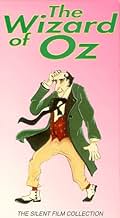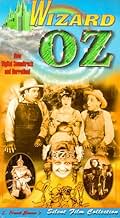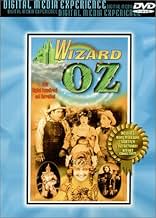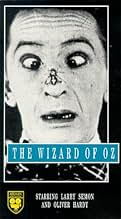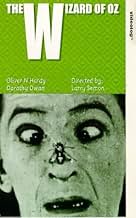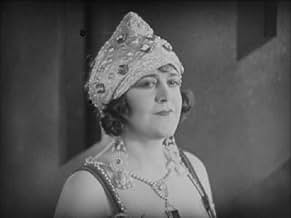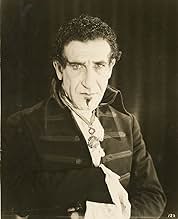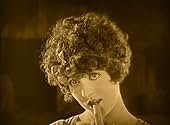VALUTAZIONE IMDb
4,9/10
1868
LA TUA VALUTAZIONE
Aggiungi una trama nella tua linguaDorothy, heir to the Oz throne, must take it back from the wicked Prime Minister Kruel with the help of three farmhands.Dorothy, heir to the Oz throne, must take it back from the wicked Prime Minister Kruel with the help of three farmhands.Dorothy, heir to the Oz throne, must take it back from the wicked Prime Minister Kruel with the help of three farmhands.
- Regia
- Sceneggiatura
- Star
- Premi
- 1 vittoria in totale
Oliver Hardy
- Woodsman
- (as Oliver N. Hardy)
- …
Curtis 'Snowball' McHenry
- Snowball
- (as G. Howe Black)
- …
Rosalind Byrne
- Herald Trumpeter
- (non citato nei titoli originali)
Chester Conklin
- Undetermined Role
- (partecipazione non confermata)
- (non citato nei titoli originali)
Wanda Hawley
- Undetermined Role
- (partecipazione non confermata)
- (non citato nei titoli originali)
Jean Johnston
- Little Girl in open & close
- (non citato nei titoli originali)
Recensioni in evidenza
I approached this film with great interest. Being a fan of Oz in general and silent film in particular, this seemed like a sure fit. Well, it's hard to put all prejudices aside, having (like most people) been bombarded with various adaptations of L. Frank Baum's book that one naturally has preconceptions.
Now, I won't bother to comment on the liberties taken in this film, the 1939 film bears, in all truth, barely a passing resemblance to Baum's dark and bizarre novel. The problem is, the changes made for this film just don't work. It's really just a standard silent slapstick film, but not a very funny one.
It's hard to sit through 90 minutes of lame jokes and vulgar stereotypes. But, as a historical curiosity, the film merits a once-over. I cannot, however, endorse the release pictured on the IMDb page, with it's "Digital Soundtrack" and "Narration." The music is inappropriate and the narration is silly...I mean, I CAN read for myself thank you! It was like sitting in the theatre with some rude patron talking to the screen! I expect this was added for children watching the films, but I really don't think many young children today would sit through this, sadly.
See it at least once, but don't expect too much from it.
Now, I won't bother to comment on the liberties taken in this film, the 1939 film bears, in all truth, barely a passing resemblance to Baum's dark and bizarre novel. The problem is, the changes made for this film just don't work. It's really just a standard silent slapstick film, but not a very funny one.
It's hard to sit through 90 minutes of lame jokes and vulgar stereotypes. But, as a historical curiosity, the film merits a once-over. I cannot, however, endorse the release pictured on the IMDb page, with it's "Digital Soundtrack" and "Narration." The music is inappropriate and the narration is silly...I mean, I CAN read for myself thank you! It was like sitting in the theatre with some rude patron talking to the screen! I expect this was added for children watching the films, but I really don't think many young children today would sit through this, sadly.
See it at least once, but don't expect too much from it.
After its 1902 tryout in Chicago, the stage play with songs by Paul Tietjens and Baum opened on Broadway in January 1903, running 293 performances before hitting the road, and returning to Broadway for four or five months in 1904. It then toured until 1911, when Baum permitted a host of amateur companies all over America to stage the play. In many areas, it became an annual event.
As Mordaunt Hall noted in his rave review in The New York Times, this version is not based on Baum's 1900 novel but on his 1902 stage musical. Many of the strange changes and eliminations in both the story and the characters were made by Baum himself. In fact, aside from the obvious enlargement of Larry Semon's role with the addition of a goodly number of comic routines, this movie is a pretty faithful transcription of the play.
True, some of the best jokes (the business with packing cases, for example), are worked to exhaustion. The main problem I find, however, is not that the stage play and movie have been converted into slapstick, but that the movie without the songs is often rather dull, despite the best efforts of Oliver Hardy and Charlie Murray.
As Mordaunt Hall noted in his rave review in The New York Times, this version is not based on Baum's 1900 novel but on his 1902 stage musical. Many of the strange changes and eliminations in both the story and the characters were made by Baum himself. In fact, aside from the obvious enlargement of Larry Semon's role with the addition of a goodly number of comic routines, this movie is a pretty faithful transcription of the play.
True, some of the best jokes (the business with packing cases, for example), are worked to exhaustion. The main problem I find, however, is not that the stage play and movie have been converted into slapstick, but that the movie without the songs is often rather dull, despite the best efforts of Oliver Hardy and Charlie Murray.
18-year-old Dorothy (Dorothy Dwan) lives on a Kansas farm, little knowing that she's actually the rightful Queen of the magical land of Oz, which is currently ruled by Prime Minister Kruel (Josef Swickard). After Kruel sends his minion Ambassador Wikked (Otto Lederer) to Kansas to try and steal the document that proves Dorothy is the queen, Dorothy and her friends are transported to Oz, where they meet the Wizard (Charles Murray) and the benevolent Prince Kynd (Bryant Washburn). Dorothy's friends are transformed into the Scarecrow (Larry Semon), the Tin Woodsman (Oliver Hardy), and the Cowardly Lion (Spencer Bell).
This was adapted, produced and directed by silent screen comedy star Larry Semon, a household name at the time, but almost entirely forgotten today. It's nearly half of the running time before Dorothy and her gang get to Oz, with much of the first half of the movie taken up by substandard comedy bits on the Kansas farm. It was strange seeing Hardy as the Tin Woodsman, and sad to see the Cowardly Lion, who spends most of the film as a stereotypical caricature named Snowball.
Semon was too extravagant with his budgets, and soon after declared bankruptcy. 2 years later he was playing supporting roles, like in von Sternberg's 1927 Underworld, before dying in 1928 at age 39 of lung disease.
This was adapted, produced and directed by silent screen comedy star Larry Semon, a household name at the time, but almost entirely forgotten today. It's nearly half of the running time before Dorothy and her gang get to Oz, with much of the first half of the movie taken up by substandard comedy bits on the Kansas farm. It was strange seeing Hardy as the Tin Woodsman, and sad to see the Cowardly Lion, who spends most of the film as a stereotypical caricature named Snowball.
Semon was too extravagant with his budgets, and soon after declared bankruptcy. 2 years later he was playing supporting roles, like in von Sternberg's 1927 Underworld, before dying in 1928 at age 39 of lung disease.
This is a strange, sometimes misogynistic, and sometimes racially stereotypical film, reflective of the time in which it was made. It fascinates on a historical level, and on a foundational comedic level. You can see the trademark Oliver Hardy gestures in development, and his interaction with Larry Semon foretells his film relationship with Stan Laurel. Some cute little animation effects (a bee enters one of Semon's ears only to exit from the other), reflective of Disney's contemporaneous mix of live action and animation.
The "digital" score and the use of a "narrator" (who horribly reads the subtitles...where did she learn to read???) is annoying.
All in all, cute, and worthy of 90 minutes.
The "digital" score and the use of a "narrator" (who horribly reads the subtitles...where did she learn to read???) is annoying.
All in all, cute, and worthy of 90 minutes.
This is a pretty weird adaptation of the "Wizard of Oz", bearing only a passing resemblance either to the original book or to the beloved Judy Garland version. The story is much different, and the characters look and act much differently. Frankly, most of it isn't really very good, although for those who enjoy silent films there are some points of historical interest.
Instead of the more familiar story of young Dorothy's trip to Oz, the scenario here has a melodrama centering on a somewhat older Dorothy (Dorothy Dwan), combined with some slapstick involving the Oz characters. In itself, it's not necessarily a big problem to adapt the story (after all, the great 1939 version also made some significant changes from the book), but this one does not really fit together very well, and it certainly does not work as well as the more familiar story. It really looks as if Larry Semon just tried far too hard to put his own personal stamp on the story, instead of simply trying to make a good movie version of the Wizard. It's interesting to see Oliver Hardy as the Tin Woodman, but he doesn't really get a lot to do, and a number of the other characters are ill-conceived, and do not work out well at all. It's also plagued with a lot of excruciating puns in the title cards, plus other similar problems.
Some of the finest movies ever made came from this era, when the silents were at their peak, and it should have been possible to make a first-rate adaptation of the Oz story, but unfortunately this isn't it. With its overdone attempts at humor and melodrama, it looks more like the stereotyped images of silent movies that are held by so many ill-informed modern moviegoers. For silent movie fans, there are still a couple of points of interest that might make it worth watching in order to satisfy one's curiosity, but otherwise there's really no particular reason to see it.
Instead of the more familiar story of young Dorothy's trip to Oz, the scenario here has a melodrama centering on a somewhat older Dorothy (Dorothy Dwan), combined with some slapstick involving the Oz characters. In itself, it's not necessarily a big problem to adapt the story (after all, the great 1939 version also made some significant changes from the book), but this one does not really fit together very well, and it certainly does not work as well as the more familiar story. It really looks as if Larry Semon just tried far too hard to put his own personal stamp on the story, instead of simply trying to make a good movie version of the Wizard. It's interesting to see Oliver Hardy as the Tin Woodman, but he doesn't really get a lot to do, and a number of the other characters are ill-conceived, and do not work out well at all. It's also plagued with a lot of excruciating puns in the title cards, plus other similar problems.
Some of the finest movies ever made came from this era, when the silents were at their peak, and it should have been possible to make a first-rate adaptation of the Oz story, but unfortunately this isn't it. With its overdone attempts at humor and melodrama, it looks more like the stereotyped images of silent movies that are held by so many ill-informed modern moviegoers. For silent movie fans, there are still a couple of points of interest that might make it worth watching in order to satisfy one's curiosity, but otherwise there's really no particular reason to see it.
Lo sapevi?
- QuizMany theatres that booked the film never received it because its production caused Chadwick Pictures to go bankrupt, and distribution ceased long before it was intended to.
- BlooperThe plane that brings Kruel's emissaries from Oz to Kansas is a triplane in midair but a biplane when it lands.
- Citazioni
Prime Minister Kruel: Do your stuff, Wizzy!
- Versioni alternative2005 DVD release on Warner Brothers (as a bonus feature with the 1939 version) alternates between sepia tone-colored images and blue-tinted images.
- ConnessioniFeatured in Wiz on Down the Road (1978)
I più visti
Accedi per valutare e creare un elenco di titoli salvati per ottenere consigli personalizzati
- How long is The Wizard of Oz?Powered by Alexa
- What is this film's connection to MGM's 1939 version with Judy Garland?
Dettagli
- Tempo di esecuzione1 ora 35 minuti
- Mix di suoni
- Proporzioni
- 1.33 : 1
Contribuisci a questa pagina
Suggerisci una modifica o aggiungi i contenuti mancanti

Divario superiore
By what name was Il mago di Oz (1925) officially released in India in English?
Rispondi

